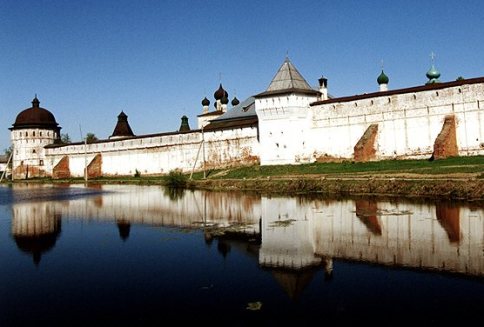

Monastery of Saint Boris and Gleb (Борисоглебский монастырь) was found in the late 14th century. It started when hermit monk Feodor or Fyodor moved to live in isolated wooden area and spend his time in fast and prayer. Three years later he was joined by his brother Paul. In 1363 Rostov was visited by a famous Russian saint and a monk Sergius of Radonezh (founder of Sergiev Posad). He was invited to Rostov to participate in reconciliation of princes. Brothers came to see him and asked for a permission to find a monastery. Sergius of Radonezh asked Rostov Prince Constantine to help hermit monks.
It was founded in 1363 by the monk Theodore, who came from
the Novgorod land, and Paul, who later joined him with the
blessing of Sergius of Radonezh, in 1363. According to The
Tale of the Borisoglebsky Monastery, Sergius of Radonezh
himself chose a place for the monastery. The founders of the
monastery are glorified as saints and are included in the
Cathedral of the Rostov-Yaroslavl Saints. Their burial is
located in the northwestern corner of the Borisoglebsky
Cathedral and serves as a place of veneration for these
saints.
The Monk Irinarkh the Recluse, who lived in
the monastery at the end of the 16th and beginning of the
17th centuries, received particular fame. His relics are
preserved under a bushel in the porch of the cathedral
church of the monastery. According to the life of the saint,
in 1612, Prince Dmitry Pozharsky and Nizhny Novgorod
townsman Kuzma Minin received a blessing from him to protect
Moscow from the Poles.
Among the church leaders who
labored in the Rostov Borisoglebsky Monastery is the
Archbishop of Rostov and Yaroslavl Tikhon (Malyshkin). The
abbot of the monastery already in modern times for some time
was the archaeographer and paleographer, collector and
researcher of monuments of ancient Russian literature
Amfilohiy (Sergievsky-Kazantsev), the future bishop of
Uglich.
The monastery became a spiritual and economic
center, around which Borisoglebsk settlements arose - a
large trading village in the Rostov district of the
Yaroslavl province, the center of the Borisoglebsk volost.
In 1764, the settlements from the possession of the
monastery were transferred by Catherine II to her favorite,
Count Grigory Orlov. On the days of the memory of Saints
Boris and Gleb, a rich fair was traditionally held near the
walls of the monastery.
In 1924, under Soviet rule,
the monastery was devastated and desecrated. During the
Soviet period, various institutions of the district center
were located in the buildings of the monastery - a post
office, a branch of the state bank, warehouses of
organizations for the preparation of flax and grain.
Divine services in the temples of the already abolished
monastery continued until October 1928. On November 8, 1928,
a local history museum (a branch of the Rostov
Museum-Reserve) was opened in the premises of the former
monastery. It was closed by order of the Yaroslavl
Department of Culture on February 8, 1954. The local history
asset of the village of Borisoglebsky united, the result of
the association was the Folk Museum formed on September 29,
1961. This museum later again became a branch of the Rostov
Museum-Reserve, and it retains this status at the present
time.
Since 1994, the museum shared premises with the
revived monastery until 2015, when all the property was
returned to the latter. The buildings of the monastery, as
constituting a significant monument of history and culture,
are under state protection.
Since 1997, every year
before the memorial day of the prophet Elijah, a procession
is made on foot from the Borisoglebsky monastery to the
source of the Monk Irinarkh in his homeland near the village
of Kondakov, 40 km from the monastery; during the
procession, the pilgrims take turns carrying the monk's
chains.
On the territory of the monastery are:
Cathedral of Boris and Gleb
(1522-1523),
Church of the Annunciation with a refectory chamber
(1524-1526),
Sergius Gate Church (1679),
Belfry with the Church of
St. John the Baptist (1690),
Cell of Irinarkh the Recluse and others.